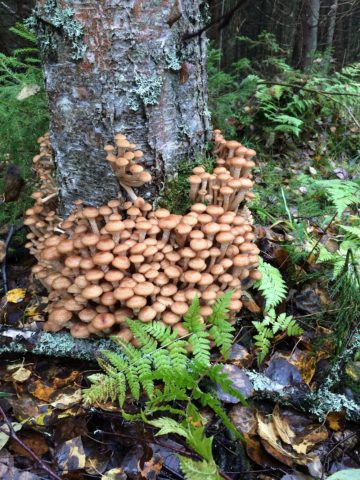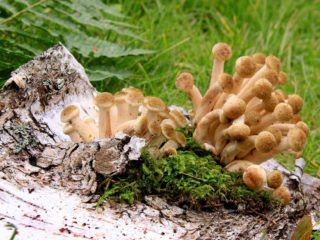Content
A photo and description of honey mushrooms on a birch will help you not to confuse this delicious mushroom with false fruiting bodies that are dangerous to human health and life. Knowing the appearance of the edible honey mushroom, you can safely go on a “quiet hunt”.
Do honey mushrooms grow on birch trees?
Different types of honey mushrooms grow on deciduous trees, but most often they can be found on birch trees. It is important to take into account the fact that the tree on which the mushrooms settle must already be dead or weakened.
What do honey mushrooms look like on a birch tree?
Birch honey mushrooms are small fruiting bodies, reaching a height of no more than 15 cm. They grow in large groups, which makes it possible to distinguish them from some parasitic mushrooms.
To be sure to recognize the honey mushroom, it is worth studying its appearance in detail. Moreover, it is almost identical for all types of these mushrooms (summer, autumn, etc.):
- Hat. In a young specimen it has a hemispherical shape. Over time, the edges begin to bend downwards, forming a kind of umbrella, in the center of which there is a small bulge.The diameter of the cap varies from 2 to 10 cm, and there are scales on its surface, but they can also disappear with age. The color of the upper part of the mushroom can vary - from light beige to reddish shades. But most often there are honey mushrooms with a yellowish-red cap.
- Pulp. In any honey mushroom it is tender and smooth, and has a yellowish-white color. For better viability, the mushroom collects water, so the inside of the fruiting body is quite moist. The aroma from birch honey fungus comes from a pleasant one, similar to the smell of damp wood.
- Leg. It grows up to 15 cm, but the color depends not only on the age of the mushroom, but also on the place in which it grows. The young specimen has a light honey color; as it grows, the lower part of the fruiting body darkens and turns brown. On the legs you can see a skirt, which is the hallmark of the mushroom, being the main distinguishing feature of the edible honey mushroom. In addition, it protects the fruiting body from breaking during strong gusts of wind.
What honey mushrooms grow under birch trees
In the photo you can see how birch honey mushrooms grow, forming a whole bracelet on destroyed stumps and parts of trees (by the way, the word honey mushroom is translated as a bracelet). Mushrooms are distributed almost everywhere. But they gained the greatest popularity among residents of Eastern Europe and Russia.
Productivity directly depends on the amount of moisture in the area where it grows. They can be found in large numbers only in deciduous forests, where the humidity level is always quite high. At the same time, all types of honey mushrooms are found there - spring, summer, autumn and winter.In mixed plantings, picking a full basket of mushrooms will be more problematic, and the quiet hunting season is also important, because in such forests they appear exclusively in the autumn.
Not only edible honey mushrooms can grow on a birch tree. Therefore, it is important to study all types of these fruiting bodies that are found on the stumps of deciduous trees.
Autumn
Autumn birch honey mushrooms belong to the Physalacriaceae family. They are found in moist forests in the Northern Hemisphere. They grow on the stumps of birch and other deciduous trees. The cap of the fruiting body grows up to 17 cm, the color is rich brown. There are many scales on the surface. The pulp is white and dense. The stem cannot exceed 11 cm in length, the diameter is approximately 15 cm. Peak yield occurs in the first ten days of September.
Summer
This species belongs to the Strophariaceae family. It can grow on birch and other deciduous trees. Prefers a temperate climate. The cap of the fruiting body is small - about 5 cm in diameter. At first the top has a semicircular shape, but then becomes almost flat. The color is matte yellow or brown, which depends on how much moisture there is in a particular season. The more precipitation there is, the lighter the shade will be. In the center of the upper part of the birch honey fungus there is a small tubercle, which stands out in a lighter tone from the rest of the surface, but with heavy rains, on the contrary, it becomes quite dark. There are no scales on the cap, but a thin mucous coating may be observed.
The stem of the mushroom does not grow more than 7 cm. It is covered with scaly formations that are dark in color; they do not disappear with age.The peak of yield occurs in the summer season, although the first birch honey mushrooms appear in April and do not disappear until November.
Winter
Winter honey fungus belongs to the families of Tricholomovaceae and Oridovaceae. Prefers to grow in northern climate zones on birch stumps and poplars. The cap of the fruiting body can vary from 2 to 10 cm in diameter. The shape is flat, the color is light yellow. The lower part of the birch honey fungus is also small - about 5-7 cm. At the same time, it is dense, on the surface there are many small villi that serve to retain moisture in the fruiting body. Hunting for this mushroom can be carried out both in spring and autumn, since it is able to tolerate even fairly low air temperatures.
Spring
Spring honey mushrooms are representatives of the Negniuchnikov family. They prefer to grow alone in mixed forests. Therefore, this species of honey mushrooms is difficult to find on birch stumps. And most novice mushroom pickers often confuse an edible specimen with some poisonous “brothers”.
Beneficial properties of birch mushrooms
To appreciate the benefits of birch mushrooms, you need to familiarize yourself with their composition. The fruiting bodies contain:
- vitamins – PP, E, B, C;
- cellulose;
- ash;
- Sahara;
- amino acids;
- microelements - potassium and magnesium, iron and sodium, calcium and copper, phosphorus and zinc.
It is also not forbidden to eat fruiting bodies during fasting.Therefore, they should be present on the table of believers who are subjected to prolonged serious stress associated with food restrictions.
Benefits of birch mushrooms:
- Since honey mushrooms contain many mineral salts of iron, magnesium, zinc and copper, their use has a beneficial effect on hematopoietic processes. Experts recommend that if you have anemia, diversify your diet with mushrooms - you can cover the daily need for these microelements by consuming only 100 g per day, which will help increase hemoglobin.
- Birch honey mushrooms have anticancer and antimicrobial effects.
- Fruit bodies allow you to cope with E. coli and Staphylococcus aureus. Lotions, ointments and tinctures are made from them.
- When consuming mushrooms, the functioning of many vital functions, in particular the thyroid gland, is normalized.
- In ancient times, people used an extract from birch mushrooms to treat minor wounds and cuts, various skin diseases, bruises and migraines.
- In Europe, the mushrooms in question are not accepted as food, but they are used to make medicines. Injections and tablets based on fruiting bodies are used for tuberculosis, to boost immunity during radiation therapy and other ailments associated with general weakening of the body and its poisoning with toxins.
In addition to the benefits, birch mushrooms can also have negative effects. Therefore, it is worth highlighting several possible problems associated with the use of honey mushrooms:
- Individual intolerance.
- Gastric ulcer in the acute stage.
- Gastritis.
- Flatulence.
Collection and consumption of birch mushrooms
The time when you can enjoy a bountiful mushroom harvest depends entirely on the climatic conditions of a particular region and the type of fruiting body. But in rainy weather, birch mushrooms are much more common. Therefore, lovers of quiet hunting prefer to go into the forest during or immediately after precipitation.
Mushroom pulp is capable of absorbing all harmful substances contained in the atmosphere. Therefore, experts strongly recommend harvesting in places that are located far from industrial enterprises and landfills, areas of roads and railways. At the same time, areas after forest fires are some of the best for silent hunting.
Today, honey mushrooms can not only be found and picked in a birch grove, many people buy them in stores. There are a number of reasons for this:
- Products grown under artificial conditions are safe for consumption.
- Mushrooms are no different from their forest counterparts, including their taste and beneficial properties.
- Raw materials can be thoroughly checked at all stages, from planting to packaging of fruiting bodies.
You can use birch honey mushrooms in different variations:
- Making soups.
- Frying.
- Pickling.
- Salting.
- Boiling.
- Drying.
- Baking.
- Use as a filling for dumplings, kulebyak and pies, as a base for salads and vegetable caviar.
Experts recommend not consuming fresh mushrooms. It is best to pre-boil the raw material and only then use it to prepare a variety of dishes.
Conclusion
A photo and description of honey mushrooms on a birch tree will allow you to accurately determine the type of fruiting body and its edibility.This information will be especially useful for beginners who enjoy quiet hunting.



















